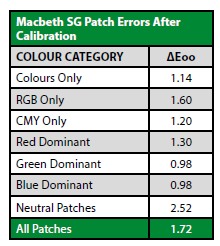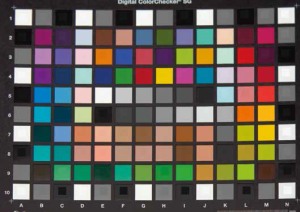articles/Review/fujigfx50s-page7
Fuji GFX 50S - A First Look - part 7 of 1 2 3 4 5 6 7
by Tom Lee Published 01/04/2017

Some Lab testing (Mike McNamee)
We were interested to test out the GFX under more controlled conditions but given the short time available, we concentrated on checking the colour accuracy of the camera. As a target we used the GretagMacgeth SG and shot a bracketed series of seven shots at 0.33EV intervals and ISO 400. The overall light quality provided by the HiSpec panel (see Big Computers in this issue) is enough to give us 1/3s at f4.0 at ISO 400 so it was a bit of a challenge for the image stabiliser. Even so Tom managed to hand hold for sufficiently crisp shots, quite a feat in itself!
The internal camera white balance estimated the colour temperature at 4,050K compared with a value of 3,864K on the spectrophotometer. When the Raw file was white balanced with the eye dropper on the ¾-tone patch of the SG, ACR reduced the CT to 3,450K. The uncorrected exposure delivered a value of 96RGB points for Adobe RGB compared with an aim of 117 points so a correction of +0.5 stops was needed. Given that the overall tone of the SG Chart is neither 50% luminance nor neutral coloured, this is well within the range we might expect. Next we took the +0.33 EV capture, corrected the white balance and exposure ready to move the result into i1Profiler for the making of a correction profile. This profile was then assigned to the target image and the result analysed using the Rags Gardner scripts (which sadly only work back to Photoshop 5 so retain your legacy installations!).

The analysis produced an average error of just 1.7Δoo almost identical to the result we obtained with our Nikon D810 (ie equally good!). The breakdown of the errors are tabled.
The importance of this test lies in the opportunity such a large chip gives for fine art reproduction. The camera will deliver a 185MB file with high accuracy right across the gamut. Note that the colour error at just on 1.0 is at the limit of detection of the unaided eye. The image size off the GFX is 8,256 by 6,192 pixels and at a modest reproduction resolution of 200ppi (for inkjet) this delivers a 30x40-inch print without interpolation. The Nikon D810 equivalent is a 24x36-inch print.
Overall then there were no surprises, the GFX is capable of delivering very high-accuracy colour under controlled conditions. Like Tom, we were impressed by the sheer size and detail of the captures, although it is merciless in terms of any skin blemishes the model’s might have! The larger chip does give a shallow depth of field when required, which is a creative bonus. First impressions are all good; we can see this camera doing well for Fujifilm and wish them luck.
Please Note:
There is more than one page for this Article.
You are currently on page 7
- Fuji GFX 50S - A First Look page 1
- Fuji GFX 50S - A First Look page 2
- Fuji GFX 50S - A First Look page 3
- Fuji GFX 50S - A First Look page 4
- Fuji GFX 50S - A First Look page 5
- Fuji GFX 50S - A First Look page 6
- Fuji GFX 50S - A First Look page 7
1st Published 01/04/2017
last update 09/12/2022 14:54:33
More Review Articles
There are 29 days to get ready for The Society of Photographers Convention and Trade Show at The Novotel London West, Hammersmith ...
which starts on Wednesday 14th January 2026





